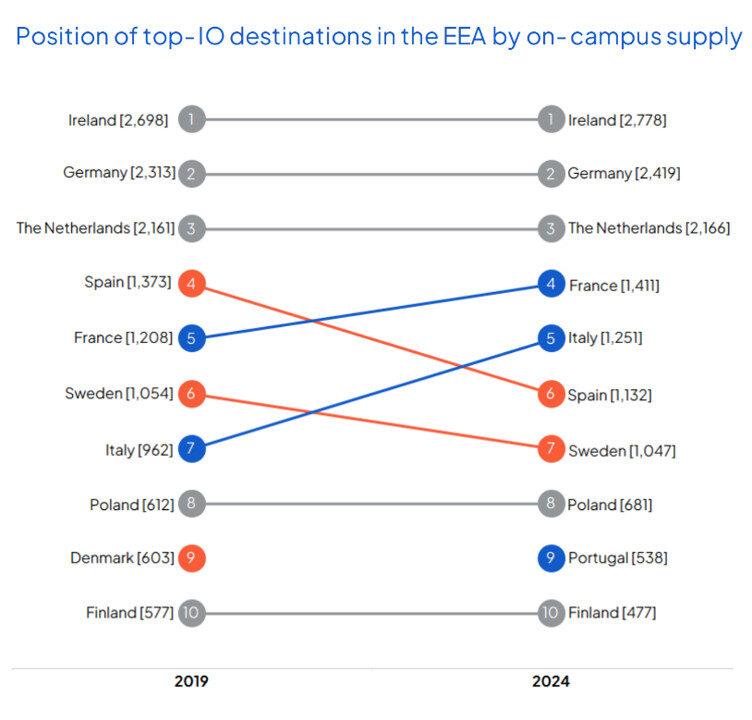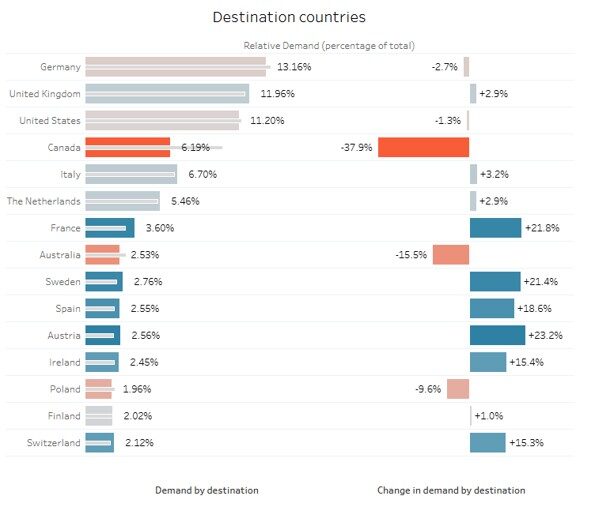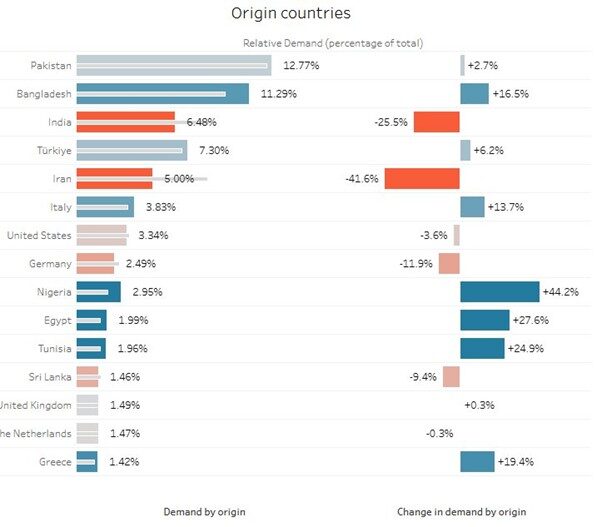Italy has achieved something remarkable in global higher education


Italy is no longer just catching up. Right now, it’s actively climbing the ranks as a preferred destination.
Italy has quietly become Europe’s 5th largest provider of English-taught university programmes, jumping from 7th place in just a few years. And the student demand data tells an even more compelling story.
At Studyportals, my role is to support Italian universities in making data-driven decisions that strengthen their international visibility and competitiveness. I’ve been tracking Italy’s performance in international education for years. And when we analysed our latest data on English-taught programmes, Italy’s numbers told a story I didn’t expect.
Italy outpaces European neighbours in programme growth
First, let me give you some context. Studyportals cooperated with the British Council IELTS to create a series of reports exploring the global provision of English-taught programmes. In June 2024, we released a detailed analysis of programme offerings across Europe.

Some key findings that stood out: Since 2021, there’s been a 22% global increase in English-taught programmes. Even more impressively, there’s been a 48% growth in such programmes in non-traditional destinations, outside the dominant English-speaking countries like the US, UK, Canada, and Australia.
Across the continent, we see that Master’s programmes dominate, accounting for over 70% of the total English-taught offer for on-campus education. Bachelor’s programmes make up the remaining 30%, with the majority concentrated in Northern and Western Europe.
When we look at the top 10 suppliers of English-taught programmes within the EEA region, there’s been remarkable stability since 2019. However, some countries stand out. Spain, Sweden, Denmark, and Finland have significantly reduced their offerings, while France, Portugal, and notably Italy have expanded theirs.
Italy, in fact, has moved from being the 7th to the 5th largest provider of English-taught programmes in Europe. That’s a significant shift and a clear sign of national momentum.
Even at the city level, Milan has emerged as a standout, ranking as the 6th most active European city in terms of English-taught programme supply.
But the demand side tells an even better story
Now I want to look at the situation within Italy. How strong the interest is for the country, where students come from and what they’re interested to study.
To give you some context, let me briefly explain how our data is collected and what makes it so special. Our data show that, on average, the student journey (from the moment a student starts looking for the perfect degree to the moment they enroll) takes more than a year. Since we are a study choice platform, we support the initial part of the student journey, which is also the longest part. This means that before students are on your radar, they are on ours.
What makes our portals so popular among students? It’s a complete source. We do not list only universities that partner with us. With more than 270,000 individual Bachelor’s and Master’s programmes listed in 117 countries, we cover more than 90% of the English-taught programmes worldwide. And it’s 100% free of charge for students. And it will always be.
Our portals support the student journey of more than 50 million unique users every year. The data reflects students’ demand data, which refers to pageviews on the programme pages on the Studyportals website.
Very remarkably, Italy is currently the 5th most searched destination on Studyportals. Globally. The only countries ahead of Italy are the traditional English-speaking giants: the UK; US; Canada; and, at the top of the list, Germany.

Where are students interested in Italy coming from?
So Italy is 5th most popular destination, but where are students interested in the bel paese from?
Here are the top 15 countries of origin for students searching for on-campus English-taught programmes in Italy. Some known trends remained stable and some others were subject to such drastic change, proving once again how fast student trends can shift in the time span of only 12 months.
Pakistan leads with 12.77% of searches, showing remarkable +27% growth. Bangladesh follows at 11.29% with strong +16.5% growth. India sits at 6.48%, though they’re down -26.5%. It’s one of those dramatic shifts that prove how quickly student trends can change. Turkey holds steady at 7.30% with +6.2% growth, while Iran has declined to 5.00% with -41.6% change.
But here’s what particularly caught our attention: Nigeria surged +44.2%, Egypt jumped +27.6%, and Greece grew +19.4%. Although they may be thought of as tiny markets, they represent thousands of students shifting their attention to Italy.

What students want to study shows interesting patterns
Students are predominantly searching for programmes based on general disciplines, rather than specific programme names. For this reason, we’re currently maintaining a list of 15 main disciplines and almost 300 subdisciplines, based on commonly used categorisations as well as past user search behaviour. When a programme is added to our database, it is attached to up to three matching disciplines which allows for easy segmentation of our data.
These are the top 15 most searched disciplines when it comes to on-campus masters and bachelors taught in English and offered by Italian institutions. It’s a mix of the usual suspects—Engineering, Business, and Computer Science—but there are also emerging areas of interest that could guide future programme development.
Computer Sciences leads at 4.14% of total demand (+3.5% growth). Management Studies holds 3.83% (+2.5% growth). Economics represents 3.49% but is declining -7.9%. General Engineering & Technology maintains 2.58% (+3.0% growth).
The growth areas that really stand out: Data Science & Big Data jumped +14.4%, Psychology climbed +10.2%, International Relations grew +11.0%, Finance increased +8.3%, and Political Science surged +10.8%.
Areas seeing decline include Architecture (-7.3%) and Design (-12.1%)—these shifts aren’t random, they reflect global employment trends and what students think about their career prospects.
So what does all this mean?
It means that Italy is no longer just catching up. Right now, it’s actively climbing the ranks as a preferred destination. But more importantly, it means that the choices Italian institutions make will define whether Italy continues to lead or falls behind.
Italy has the opportunity to position itself in the international education market. Not just as a participant, but as a leader. That means continuing to innovate, collaborate, and above all, listen to the signals students are already sending us.
Remember, that student journey averages more than a year from search to enrolment. The 50+ million students currently exploring options on our platform represent incoming classes through 2026 and beyond. So this data doesn’t just show that Italy has future potential; it’s actually concrete pipeline data showing sustained interest in Italian higher education.
So the question isn’t whether Italy belongs in the conversation with the traditional education powerhouses. The data shows it’s already there. The question is how much further it can climb.


